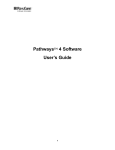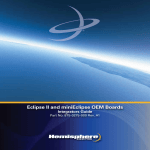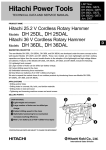Download Eos Arrow Manual
Transcript
ARROW GNSS SERIES TM USER’S MANUAL (SBAS) Release Date: June 2015 (rev 1.0) COPYRIGHT NOTICE © Copyright 2015 Eos Positioning Systems Inc. All rights reserved. No part of this manual may be stored in a retrieval system, transmitted, or reproduced by any means, including, but not limited to photocopy, photograph, digitizing, or otherwise, without the prior written permission from Eos Positioning Systems Inc. TRADEMARKS The Eos logo, Arrow Lite™, Arrow 100™, and Arrow 200™ are trademarks of Eos Positioning Systems Inc. The Bluetooth™ trademarks are owned by Bluetooth SIG Inc., USA. Apple, iPad, iPhone, and iTunes are trademarks of Apple Inc., registered in the US and other countries. iPad mini is a trademark of Apple Inc. App Store is a Service Mark of Apple Inc. iOS is a trademark or registered trademark of Cisco in the U.S. and other countries and is used under license. Other product and company names mentioned herein may be trademarks of their respective companies. All other trademarks are the property of their respective owners. Made for iPhone 5s, iPhone 5c, iPhone 5, iPhone 4s, iPad Air, iPad mini 2, iPad (3rd, and 4th generation), and iPad 2. “Made for iPhone”, and “Made for iPad" mean that an electronic accessory has been designed to connect specifically to iPhone, or iPad, respectively, and has been certified by the developer to meet Apple performance standards. Apple is not responsible for the operation of this device or its compliance with safety and regulatory standards. Please note that the use of this accessory with iPhone, or iPad may affect wireless performance. FCC NOTICE This device complies with Part 15 of the FCC Rules. Operation is subject to the following two conditions: (1) this device may not cause harmful interference, and (2) this device must accept any interference received, including interference that may cause undesired operation. NOTE: This equipment has been tested and found to comply with the limits for a Class B digital device, pursuant to part 15 of the FCC Rules. These limits are designed to provide reasonable protection against harmful interference in a residential installation. This equipment generates, uses and can radiate radio frequency energy and, if not installed and used in accordance with the instructions, may cause harmful interference to radio communications. However, there is no guarantee that interference will not occur in a particular installation. If this equipment does cause harmful interference to radio or television reception, which can be determined by turning the equipment off and on, the user is encouraged to try to correct the interference by one or more of the following measures: - Reorient or relocate the receiving antenna. - Increase the separation between the equipment and receiver. - Connect the equipment into an outlet on a circuit different from that to which the receiver is connected. - Consult the dealer or an experienced radio/TV technician for help. Arrow Series User’s Manual (SBAS) i EOS LIMITED W ARRANTY Eos Positioning Systems Inc. hereby warrants solely to the end purchaser of the Products, subject to the exclusions and procedures set forth herein below, that the Products sold to such end purchaser shall be free, under normal use and maintenance, from defects in material and workmanship for a period of 24 months from delivery date to such end purchaser. Repairs and replacement components are warranted, subject to the exclusions and procedures set forth below, to be free, under normal use and maintenance, from defects in material and workmanship for 90 days from performance or delivery, or for the balance of the original warranty period, whichever is greater. Battery packs are warranted for a period of 90 days. PURCHASER’S EXCLUSIVE REMEDY The end purchaser’s exclusive remedy under this warranty shall be limited to the repair or replacement, at the option of Eos, of any defective Products or components thereof. The end user shall notify Eos or an Eos approved service center immediately of any claimed defect. Repairs shall be made through an Eos approved service center only. EXCLUSIONS Eos does not warrant damage occurring in transit or due to misuse, abuse, improper installation, neglect, lightning (or other electrical discharge) or fresh/salt water immersion of Products. Repair, modification or service of Eos Products by any party other than an Eos approved service center shall render this warranty null and void. Eos does not warrant claims asserted after the end of the warranty period. Eos does not warrant or guarantee the precision or accuracy of positions obtained when using Products. Products are not intended for primary navigation or for use in safety of life applications. The potential accuracy of Products as stated in Eos literature and/or Product specifications serves to provide only an estimate of achievable accuracy based on: • Specifications provided by the US Department of Defense for GPS Positioning, • GPS OEM Receiver specifications of the appropriate manufacturer (if applicable), and • DGPS service provider performance specifications. Eos reserves the right to modify Products without any obligation to notify, supply or install any improvements or alterations to existing Products. NO OTHER W ARRANTIES THE FOREGOING WARRANTY IS EXCLUSIVE OF ALL OTHER WARRANTIES, WHETHER WRITTEN, ORAL, IMPLIED OR ARISING BY STATUTE, COURSE OF DEALING OR TRADE USAGE, IN CONNECTION WITH THE DESIGN, SALE, INSTALLATION, SERVICE OR USE OF ANY PRODUCTS OR ANY COMPONENTS THEREOF, INCLUDING, BUT NOT LIMITED TO, ANY WARRANTY OF MERCHANTABILITY OR FITNESS FOR A PARTICULAR PURPOSE. LIMITATION OF LIABILITY THE EXTENT OF EOS’S LIABILITY FOR DAMAGES OF ANY NATURE TO THE END PURCHASER OR ANY OTHER PERSON OR ENTITY WHETHER IN CONTRACT OR TORT AND WHETHER TO PERSONS OR PROPERTY SHALL IN NO CASE EXCEED, IN THE Arrow Series User’s Manual (SBAS) ii AGGREGATE, THE COST OF CORRECTING THE DEFECT IN THE PRODUCT OR, AT EOS’S OPTION, THE COST OF REPLACING THE DEFECTIVE ITEM. IN NO EVENT WILL EOS BE LIABLE FOR ANY LOSS OF PRODUCTION, LOSS OF PROFITS, LOSS OF USE OR FOR ANY SPECIAL, INDIRECT, INCIDENTAL, CONSEQUENTIAL OR CONTINGENT DAMAGES, EVEN IF EOS HAS BEEN ADVISED OF THE POSSIBILITY OF SUCH DAMAGES. WITHOUT LIMITING THE FOREGOING, EOS SHALL NOT BE LIABLE FOR ANY DAMAGES OF ANY KIND RESULTING FROM INSTALLATION, USE, QUALITY, PERFORMANCE OR ACCURACY OF ANY PRODUCTS. GOVERNING LEGISLATION To the greatest extent possible, this warranty shall be governed by the laws of the Province of Quebec (Canada). In the event that any provision hereof is held to be invalid by a court of competent jurisdiction, such provision shall be severed from this warranty and the remaining provisions shall remain in full force and effect. OBTAINING W ARRANTY SERVICE In order to obtain warranty service, the end purchaser must bring the Product to an Eos approved dealer, along with the end purchaser’s proof of purchase. For any questions regarding warranty service or to obtain information regarding the location of any of Eos’s dealers, contact Eos at the following address: Eos Positioning Systems Inc. 191A rue Saint-André Terrebonne, Quebec, Canada J6W 3C4 Telephone number: +1(450) 824-3325 E-mail address: [email protected] Web site: www.eos-gnss.com Arrow Series User’s Manual (SBAS) iii TABLE OF CONTENTS PREFACE .............................................................................................................................................. V CUSTOMER SERVICE.............................................................................................................................. V WEB SITE .............................................................................................................................................VI DOCUMENT CONVENTIONS .....................................................................................................................VI NOTES, CAUTIONS, AND WARNINGS .......................................................................................................VI 1. GETTING ACQUAINTED WITH YOUR ARROW ......................................................................................... 1 1.1 UNPACKING YOUR ARROW RECEIVER ............................................................................................... 1 1.1.1 Arrow Lite GPS - GIS Package................................................................................................ 1 1.1.2 Arrow 100 GNSS - GIS Package............................................................................................. 2 1.1.3 Arrow 200 GNSS – High-Accuracy GIS Package .................................................................... 2 1.1.4 Optional / Replacement Accessories....................................................................................... 3 1. GIS Utility Vest............................................................................................................................. 3 1.2 FEATURES AND DESCRIPTION OF MAIN COMPONENTS ......................................................................... 3 1.2.1 Arrow Series Features, Comparison and Options.................................................................... 3 1.2.2 Receiver Description ............................................................................................................... 2 1.2.2.1 Arrow Overview ................................................................................................................ 3 1.2.2.2 LED Interface Description................................................................................................. 4 1.2.2.3 Battery Care and Maintenance ......................................................................................... 6 2. SETTING UP CONNECTIVITY ................................................................................................................ 7 2.1 BLUETOOTH CONFIGURATION........................................................................................................... 7 2.1.1 iOS (Apple iPhone, iPad)......................................................................................................... 7 2.1.2 Android Devices .................................................................................................................... 11 2.1.3 Windows ............................................................................................................................... 12 2.1.3.1 Example with Windows 7 and 8...................................................................................... 12 2.1.3.2 Example with Windows 10 Native Stack ......................................................................... 15 2.1.4 Windows Mobile .................................................................................................................... 17 2.2 INSTALLING THE USB DRIVERS FOR WINDOWS ............................................................................... 20 2.3 AVAILABLE SOFTWARE UTILITIES FROM EOS .................................................................................. 22 2.3.1 Apple iOS.............................................................................................................................. 22 2.3.2 Android.................................................................................................................................. 22 2.3.3 Windows ............................................................................................................................... 22 2.3.4 Windows Mobile .................................................................................................................... 22 3. RECEIVER OPERATION WITH SBAS .................................................................................................. 23 3.1 WHAT TO KNOW ABOUT SBAS ....................................................................................................... 23 3.2 SETTING UP FOR FIELD WORK ......................................................................................................... 24 3.2.1 Using the Carrying Case and Softhat .................................................................................... 24 3.2.2 Using a Utility Vest and Pole ................................................................................................. 24 3.3 CONFIGURING THE ARROW FOR SBAS WITH EOS UTILITY................................................................ 24 3.3.1 RX Config Menu - Default Values.......................................................................................... 25 3.3.2 Default NMEA Output on Bluetooth and USB Ports............................................................... 28 3.4 COLLECTING DATA IN THE FIELD ..................................................................................................... 29 3.4.1 Eos Tools Pro Configuration for iOS and Android.................................................................. 29 3.4.2 Common Practice for SBAS Operations ................................................................................ 31 3.4.2.1 Using your off-the-shelf software .................................................................................... 31 3.4.2.2 Field data collection guidelines....................................................................................... 31 Arrow Series User’s Manual (SBAS) iv PREFACE Welcome to the Arrow Series™ Manual and congratulations on purchasing this high-performance GPS/GNSS receiver. The Arrow provides a high level of performance, delivering the following accuracies: Arrow Lite GPS: Sub-meter using built-in SBAS (WAAS/EGNOS/MSAS/GAGAN). Supports GPS constellation only. Arrow 100 GNSS: Sub-meter using built-in SBAS (WAAS/EGNOS/MSAS/GAGAN). Real-time sub-foot using RTK. Supports all GNSS constellations (GPS, GLONASS, BeiDou, Galileo, QZSS). Arrow 200 GNSS: Sub-meter using built-in SBAS (WAAS/EGNOS/MSAS/GAGAN). Worldwide realtime sub-decimeter using Atlas global correction subscription service. 1cm using RTK. Multifrequency. Supports all GNSS constellations (GPS, GLONASS, BeiDou, Galileo, QZSS). For all of the Arrow receivers, data is output at 1Hz (once per second) and optionally up to 20Hz. The Arrow provides a high level of performance, delivering either submeter positioning using the builtin SBAS demodulator, centimeter positioning using RTK, or worldwide submeter, sub-foot or subdecimeter accuracy using LBand Satellite subscription, at up to a 20Hz output (optional). The Arrow Series features raw measurement output and delivers excellent phase measurement quality for postprocessing and RTK applications. It also offers independent universal Bluetooth (compatible with iOS, Android and Windows operating systems), and USB communication ports. This document is meant to assist a customer in becoming familiar with the Arrow receiver functionality and system operation, and it assumes that you, the end-user, is familiar with the basic concepts of GNSS receiver operations. The chapters that follow provide detailed information on the receivers, including the hardware and software interface, in addition to various descriptions of technologies and features that they support. CUSTOMER SERVICE If you encounter problems during the installation or operation of this product, or cannot find the information you need, please contact your dealer, or Eos Customer Service. The contact number and e-mail address for Eos Customer Service are: Telephone number: +1(450) 824-3325 E-mail address: [email protected] Technical Support is available from 8:30 AM to 5:00 PM Eastern Time, Monday to Friday. To expedite the support process, please have the product model and serial number available when contacting Eos Customer Service. In the event that your equipment requires service, we recommend that you contact your dealer directly. However, if this is not possible, you must contact Eos Customer Service to obtain a Return Merchandise form before returning any product to Eos. If you are returning a product for repair, you must also provide a fault description. Arrow Series User’s Manual (SBAS) v WEB SITE Eos maintains a Web home page at the following address: www.eos-gnss.com A corporate profile and product information is available through the site or by contacting Eos at [email protected]. DOCUMENT CONVENTIONS Bold is used to emphasize certain points. Unless otherwise specified, the terms the Arrow Series™, Arrow GNSS, Arrow receiver and Arrow are used for simplicity to describe common features of all three models: Arrow Lite, Arrow 100, and Arrow 200. NOTES, CAUTIONS, AND WARNINGS Notes, Cautions, and Warnings stress important information regarding the installation, configuration, and operation of the Arrow receiver. Note - Notes outline important information of a general nature. Cautions - Cautions inform of possible sources of difficulty or situations that may cause damage to the product. Warning - Warnings inform of situations that may cause harm to you. Arrow Series User’s Manual (SBAS) vi 1. GETTING ACQUAINTED WITH YOUR ARROW This chapter describes the accessories included with the Arrow receiver kits and the various optional accessories available through your dealer. If you are new to GPS/GNSS, SBAS, RTK or AtlasTM LBand services, we recommend that you browse our website for further information on these services and technologies. 1.1 UNPACKING YOUR ARROW RECEIVER If you find that any of these items listed below are damaged due to shipment, please contact the freight carrier immediately for assistance. When you unpack your Arrow receiver, please ensure that it is complete by comparing the parts received against the packing slip. There are two types of packages available: Standard GIS package for the Arrow Lite GPS and Arrow 100 GNSS and the High-Accuracy GIS package for the Arrow 200 GNSS. GIS and Survey accessories and kits are available for any of the three models. Unless your system has been equipped differently than a Standard or High-Accuracy GIS Package, the following parts should be included: 1.1.1 Arrow Lite GPS - GIS Package 1. Arrow receiver with Arrow Smart Battery Pack 2. L1 GPS Precision Antenna (029) with removable magnets 3. Two-section Antenna Cable 4. Spare Antenna Cable 5. Softhat for Antenna 6. Nylon Carrying Case (belt clip & shoulder strap) 7. 12V International Power Supply for Arrow Smart Battery 8. USB Data Cable Figure 1-1 : Arrow Lite GPS - GIS Package Content Note – If you find any discrepancy between your packing slip and the content of your shipment, please contact your reseller immediately. 1.1.2 Arrow 100 GNSS - GIS Package 1. Arrow receiver with Arrow Smart Battery Pack 2. Single-Frequency GNSS / LBand Precision Antenna (304) with removable magnets 3. Two-section Antenna Cable 4. Spare Antenna Cable 5. Softhat for Antenna 6. Nylon Carrying Case (belt-clip & shoulder strap) 7. 12V International Power Supply for Arrow Smart Battery 8. USB Data Cable Figure 1-2 : Arrow 100 GNSS - GIS Package Content 1.1.3 Arrow 200 GNSS – High-Accuracy GIS Package 1. Arrow 200 receiver with Arrow Smart Battery Pack 2. Dual-Frequency GNSS / LBand Precision Antenna (504) with removable magnets 3. Large Antenna Mounting Plate 4. Two-section Short Antenna Cable for survey pole 5. Spare Antenna Cable 6. Arrow Pole Mount Bracket 7. Range Pole Clamp 8. USB Data Cable 9. 12V International Power Supply for Arrow Smart Battery pack 10. Hard Shell Case Figure 1-3: Arrow 200 GNSS – High-Accuracy GIS Package Arrow Series User’s Manual (SBAS) 2 1.1.4 Optional / Replacement Accessories 1. GIS Utility Vest 2. Backpack/Utility Vest Rangepole 3. Small Antenna Mounting Plate 4. Softhat for Antenna 5. Nylon Carrying Case (clip & shoulder strap) 6. GNSS Survey Antenna 7. 4” (10 cm) Magnetic Mount 8. Arrow Pole Mount Bracket 9. Range Pole Clamp 10. Large Antenna Mounting Plate 11. External Power Module (EPM) 12. 12V International Power Supply 13. Two-section Standard Cable 14. Two-section Short Cable 15. Two-section survey antenna cable 16. One-section Spare Cable 1.2 FEATURES AND DESCRIPTION OF MAIN COMPONENTS This section unveils the key features of the Arrow series with a comparison of the three models: Arrow Lite GPS, Arrow 100 GNSS and Arrow 200 GNSS. Section 1.2.2 presents the physical characteristics of the Arrow and describes the LED user interface along with considerations on the Smart Li-Ion battery pack. 1.2.1 Arrow Series Features, Comparison and Options Model Arrow Lite GPS Arrow 100 GNSS Arrow 200 GNSS Description Single Frequency GPS Single Frequency GNSS Multi-Frequency GNSS GLONASS / Beidou --- √ √ Gallileo / QZSS --- Future Option Future Option SBAS Channels 2 3 3 SBAS Accuracy 30-60 cm 30-60 cm 30-60 cm OmniSTAR VBS --- --- AtlasTM H100 Future Option H100 Future Option H100 / H30 / H10 RTK Network RTCM 2.1 Fully Compatible Fully Compatible DGNSS Accuracy Submeter Sub-foot Sub-foot RTK Accuracy --- 1 cm 1 cm Bluetooth iAP / SPP √ √ √ 10-20Hz Output Option Option Option Battery Autonomy 16 hours 12 hours 9 hours ® Some notable features of the Arrow receivers are: • Multi-Constellation support for GPS, GLONASS, BeiDou, QZSS and Galileo • 3 channels dedicated to SBAS tracking • All models feature optional integrated LBand radio to support AtlasTM differential correction services for worldwide, real-time submeter, subfoot or sub-decimeter positioning • 30-60cm horizontal accuracy with SBAS (WAAS, EGNOS, MSAS, GAGAN) Arrow Series User’s Manual (SBAS) 3 • Raw measurement output (via documented binary messages) or RINEX converter • Position and raw measurement update rates of up to optional 10Hz or 20Hz • COAST™ technology provides consistent performance with old correction data and guarantees an all-day DGPS/DGNSS solution even in forestry applications (with suitable SBAS or Atlas coverage) • Optional Auto-Dif: A base station-free way of differentially positioning for submeter applications • Support base and rover modes • Universal Bluetooth 2.1 + EDR (supported profiles: iAP for Apple iOS and SPP for Windows and Android) ensures compatibility with any up-to-date handheld/tablet/computer/smartphone and software combination • One USB 2.0 compliant port can be used for configuration, or to output/receive RTCM corrections and/or NMEA messages • Integrated, field-replaceable Smart Li-Ion battery with built-in charger for full day operation The comparison chart above can be found on our website (www.eos-gnss.com), and offers a more succinct demonstration of the Arrow Series™ capabilities as well as the differences between models. 1.2.2 Receiver Description The Arrow receiver consists of three main parts to be operational: the receiver itself, the Smart Li-Ion battery pack and the antenna (with cable). This section describes the LED interface and points out some considerations regarding care and maintenance of the smart battery pack. Power Button Smart Li-Ion Battery Pack Main LED Interface Smart Battery LED Interface Arrow Series User’s Manual (SBAS) 2 1.2.2.1 Arrow Overview Power Button Smart Battery Pack Antenna Connector (SMA Female) DC Charging Jack 1.7mm Positive Center Pin (9 to 16 VDC Max) Mini USB Receptacle (Type B) Main LED Interface Battery LED Interface #4-40 Mounting Inserts (2x) Battery Thumb Screw Arrow Series User’s Manual (SBAS) 3 Battery Contacts Watertight Membrane Vent (Do not puncture!) Bluetooth Radio Switch Gasket 1.2.2.2 LED Interface Description The diagnostic LEDs provide a quick indication of the receiver’s status. These LEDs are visible on the front panel and provide the following information: Power Bluetooth GNSS Status Arrow Series User’s Manual (SBAS) 4 LED Description Power – This red LED illuminates to indicate a power-on status of the Arrow. When battery voltage is low, the Power LED will start blinking about 15-20 minutes before auto shut-down. GPS – The GPS green LED will turn on once the Arrow is computing a valid position/fix. A blinking state would indicate a receiver malfunction. DGPS – A solid state of this orange LED indicates that the Arrow is in DGNSS (differential correction) mode. The conditions are that it has successfully applied differential correction to its position (see DIFF LED below) and the pseudorange residuals are below the threshold set by the $JLIMIT command (default is 10.0) and the position is in 3D. A blinking state can be caused by any of the following: - differential correction is no longer being received by the Arrow (DIFF LED will be off). In this case the LED will blink till the value set by the $JAGE command is reached (default is 3600 seconds). If using SBAS, the receiver will stay in DGNSS mode. If using RTK corrections, it will be an indication that the Arrow is not in a fixed ambiguity mode but is in a Float condition. - the receiver is in 2D mode - the pseudorange residual set by the $JLIMIT command has been exceeded - the PDOP threshold value set by the $JALT,SOMETIMES,pdop has been exceeded An off state means the Arrow’s position is not being differentially corrected. Note that the Arrow’s data output flow is not altered by these LED states. DIFF – This yellow indicator will illuminate continuously when the Arrow has achieved a solid SBAS or LBand (Atlas or OmniSTAR) lock (depending on model) with better than a 150 bit error rate (BER) or when it is successfully receiving RTCM/RTK corrections. For example, if the SBAS signal strength is low (BER higher than 150) but the receiver is still locked, this LED will blink, showing that lock is marginal . Bluetooth – This blue LED will illuminate when there is a Bluetooth connection between the Arrow and a Bluetooth compatible device. It will be in a blinking state when there is no Bluetooth connection. It will be off if the Bluetooth miniature DIP switch, between the main battery contacts, is in the OFF position (in this case use the tip of a pen or sharp screwdriver to slide the switch to its ON position). Arrow Series User’s Manual (SBAS) 5 1.2.2.3 Battery Care and Maintenance The Arrow Smart Battery Pack features the following: - 7.2V (nominal) Lithium-Ion cells with a 3,350mAh capacity - Integrated charger only requires a power source of 9-16V with 1.5Amp minimum current - Intelligent battery fuel gauge with 5-LED display and learning algorithm - Li-Ion Safety protection circuitry - DC Jack with 1.7mm positive center pin Battery Contacts (Do not short-circuit!) Waterproof Membrane Vent (Do not puncture!) Fuel Gauge Push Button Charge Indicator Fuel Gauge Indicator DC Power Jack 1.7mm Positive Center Pin (9 to 16 VDC Max) Since the Arrow battery pack features built-in charge circuitry, only use the Eos-supplied charger. Do not use an external Li-Ion charger with the Arrow battery pack. Do not short-circuit the battery contacts; If the contacts are short-circuited, the battery pack and the fuel gauge will be disabled. To reset the internal fuse, simply connect the power supply to the DC jack on the side of the pack. To recharge the battery pack, connect the 12V power supply to the DC power jack on the side of the unit. If the battery has reached a low state (red blinking LED on the fuel gauge bar graph) turn off the Arrow and allow the battery to recharge for at least half an hour before operating the unit while charging. The charge LED will switch from Red to Green when charge is completed and battery is full. It is not recommended to operate the Arrow continuously for more than two or three days while charging the Li-Ion battery pack; in this case consider using the Arrow EPM (External Power Module). If the battery has gone through a deep discharge and was left connected to the receiver (Arrow will use minimal battery power even when turned off) for a few days, the built-in charger will first go through a trickle charge for about 30 minutes. If the internal battery voltage has not reached its normal charging threshold, the charge LED might turn off because of a safety timer. In this case, disconnect and reconnect the charger to allow the battery to reach its normal high current charge state. It should normally take about 4 hours to fully recharge the battery pack. Do not leave battery on the shelf for more than 3 months without being recharged. The Li-Ion cells in the pack might be damaged. If a long-term storage is anticipated, charge the battery pack half of full capacity and remove it from the Arrow receiver. Recharge the pack once every 3 months. Another safety feature of the Arrow Battery Pack is internal temperature monitoring. Wait for the battery pack to reach room temperature before recharging. Do not recharge the pack if the temperature is either below 5°C or above 35°C. Do not puncture the membrane vent. Arrow Series User’s Manual (SBAS) 6 2. SETTING UP CONNECTIVITY Chapter 2 is a guide to setting up Bluetooth and USB connectivity under various Operating Systems. 2.1 BLUETOOTH CONFIGURATION The steps involved in configuring a Bluetooth accessory with a device shows some differences depending on the OS being used (iOS, Android, Windows, Windows Mobile), the revision/version of it and the manufacturer of the Bluetooth Stack installed on the computer (ex. Toshiba, Microsoft, Broadcom, IVT Corporation’s Bluesoleil, etc.). No specific Bluetooth driver is required for the Arrow as it supports standard protocols. If your device requires a driver, it is most likely because its Bluetooth stack is not properly installed/configured or requires a driver update. Please consult with your computer manufacturer or IT department. Note that there are in general three distinct steps in the Bluetooth setup process (except for iOS): 1) Discovering. The Arrow will be listed as an available device. Bluetooth LED will be blinking. 2) Pairing. After the Arrow is selected, an exchange of information occurs between the device and the Arrow (passkeys, service, addresses, etc). The Arrow Bluetooth LED will still be blinking. 3) Connecting with the Arrow (either manually or more commonly within the user application calling an assigned COM port). The Bluetooth LED on the Arrow will illuminate to indicate that a connection has been established with the device/computer. In Windows and Android, this won’t begin until the application software on your device requests data from the Arrow. 2.1.1 iOS (Apple iPhone, iPad) All Arrow receivers are manufactured under an official Bluetooth certification by Apple. Configuring and using the Arrow with an iOS device is a simple process: Pairing and Connecting are done in one step after the discovery. Go to the “Settings” menu on your iPhone/iPad and select “Bluetooth”. Turn on the Bluetooth radio and let the device discover the Arrow. Arrow Series User’s Manual (SBAS) 7 Tap on the Arrow receiver and allow a few seconds for the two to pair and connect. Once the Arrow is connected, Go to the “General”/”About” menu and … Arrow Series User’s Manual (SBAS) 8 … tap on the “Eos GNSS Receiver” that will be listed towards the bottom of the page. Information specific to your Arrow will be provided in this page. Arrow Series User’s Manual (SBAS) 9 The Arrow automatically replaces all location information on the iOS device with its more accurate position. You may now launch Eos Tools or Eos Tools Pro utility software downloadable from the App Store. Note: The Arrow stores the Bluetooth address of the last iOS device it was paired with. When the two units are turned on, they will automatically connect to each other. To pair with a different iOS device, the Bluetooth radio of the previous device should be turned off or out of range of the Arrow’s Bluetooth and the pairing process should be repeated with the new device. Arrow Series User’s Manual (SBAS) 10 2.1.2 Android Devices To configure the Arrow with an Android device via Bluetooth, go to your Android “Settings” and select the Bluetooth icon. Turn ON the Bluetooth radio and the Arrow will be discovered and listed. Tap on the Arrow under the “Available devices” and allow a few seconds to pair. If your Android application has been written to connect directly to a Bluetooth Port and supports an NMEA stream from a GNSS receiver, then the Arrow will be listed and selectable within your application. Otherwise, Mock GPS feature should be enabled to allow the Arrow to populate the Android Location Service. Eos Tools Pro is available free of charge from Google Play. Download and install. In the “Settings” pull-down, select the Arrow from the list, tap on “Start”. Check the “Enable Mock Location” feature to allow the Android Location Service to be populated with the Arrow’s position coordinates. Arrow Series User’s Manual (SBAS) 11 2.1.3 Windows The Arrow follows the Bluetooth v2.1 standard and thus supports Secure Simple Pairing (SSP). In this process, a passkey is not required as the two parties exchange information transparently in the background during the pairing process. Bluetooth Stacks under the Windows operating system should not normally ask for a passkey. In case a passkey is required by your computer: The Arrow Bluetooth Passkey is: “1 2 3 4 5 6 7 8” It is also important to make sure of two things: 1) Your computer’s Bluetooth settings allow Serial Port Profile (SPP) in order to communicate with the Arrow. 2) All drivers are up-to-date for the Bluetooth radio installed in your computer. An exclamation mark next to a Windows default Bluetooth icon is an indication of a malfunction and you should seek help from your computer specialist. After the Arrow has been assigned an (outgoing) COM port number, your software application will call this port number to establish a connection. It is NOT necessary to assign a baud rate for Bluetooth connections to a device over SPP profile (contrarily to USB and Serial port connections). 2.1.3.1 Example with Windows 7 and 8 From the Windows Taskbar, “Show the hidden Icons” and click on the Bluetooth icon. Select “Add a Device”. Arrow Series User’s Manual (SBAS) 12 In the first window, select the Arrow, click on next and wait for the pairing to complete. During the process there might be an error notification and Windows will try to look for drivers for the Arrow. This is due to a glitch in the Win 7 / Win 8 Microsoft stack trying to pair also with the Apple protocol published by the Arrow. This error will not happen for other Bluetooth stacks or in Windows 10 and is not harmful as the SPP profile of the Arrow will be properly detected. Arrow Series User’s Manual (SBAS) 13 In order to fix this problem, right click on the Arrow icon and select “Properties” In the “Hardware” tab, a communication port will be assigned to the Arrow for your software to communicate with it. In this example COM7. (Some Bluetooth stacks will assign both an Incoming and an Outgoing port; your application must connect to the Arrow via the Outgoing port). Notice the exclamation mark next to the “Bluetooth Peripheral Device”. To remove the error, click on the “Service” tab and uncheck the “Apple” service. Click on the OK button to finish. The Arrow icon will now appear in the list of Bluetooth devices without any error. Arrow Series User’s Manual (SBAS) 14 2.1.3.2 Example with Windows 10 Native Stack In Windows 10, click on the Bluetooth icon on your Taskbar and select “Add a Bluetooth Device”. If the Bluetooth icon does not appear in the Taskbar, this probably means that the Bluetooth radio on your computer is off. To turn it on, go to your Windows “Settings” and select “Devices”. In the next window, select “Bluetooth” and under “Manage Bluetooth devices”, set the Bluetooth button to its “ON” position. Arrow Series User’s Manual (SBAS) 15 After a few seconds, your Arrow will be displayed in the list of available devices with a “Ready to Pair” message. Click on the Arrow name, then on the “Pair” button. To find out which COM port is assigned to the Arrow after the pairing process, click on “More Bluetooth options” under “Related settings”. In the “Bluetooth Settings” window, select the “COM Ports” tab. There will be an Incoming and an Outgoing port number listed. Your software must communicate with the Arrow using the Outgoing port (in this example, COM9). Arrow Series User’s Manual (SBAS) 16 2.1.4 Windows Mobile Setting up Bluetooth on Windows Mobile devices requires some extra steps compared to the previous operating systems described in this chapter. The example in this section shows the flow for Windows Mobile 6.1 but the configuration for other versions of Windows Mobile is similar. In your Windows Mobile “Communication Manager” found under “Settings”, turn on the Bluetooth radio by tapping on the Bluetooth icon (will turn yellow in this example). Tap on “Settings” in the bottom menu and select “Bluetooth”. In the Bluetooth “Settings” window that appears, select “Add new device…” under the “Devices” tab. The Arrow will be discovered and listed. Tap on the Arrow name and then tap “Next”. Arrow Series User’s Manual (SBAS) 17 The next window prompts for a passcode (or passkey): The Arrow Bluetooth Passkey is: “1 2 3 4 5 6 7 8” Enter the “12345678” passcode, then tap “Next”. (Some versions of Windows Mobile might ask to enter the passcode again; just tap next to ignore this 2nd request). In the next window, the SPP (Serial Port Profile) of the Arrow is detected but you must confirm by checking the “Serial Port” box. Tap on “Finish” and the paired Arrow will now be displayed. (Some versions of Windows Mobile will not automatically show the “Serial Port”, but instead will show and “Advanced” option at the bottom of the page. In this case, click on “Advanced” and check the “Serial Port” option box). Arrow Series User’s Manual (SBAS) 18 In this next step, a COM port will be assigned manually to the Arrow. Select the “COM Ports” tab in the bottom menu, and then tap on “New Outgoing Port”. Select the newly paired Arrow and tap on “Next”. In the pull-down menu, all COM ports will be listed. Select COM9 or COM8. (It is highly recommended to select a COM port in the upper values, usually between COM9 and COM6 (as most of the ones with lower numbers will already be in used internally by Windows Mobile but unfortunately listed here in this pull-down)). Uncheck the “Secure Connection” box and tap “Finish”. Your Arrow is now ready to be “called” by your software on this assigned COM port. Arrow Series User’s Manual (SBAS) 19 2.2 INSTALLING THE USB DRIVERS FOR WINDOWS Manual USB Driver installation is not necessary for Windows 7, 8 and 10 operating systems as it is distributed by the Microsoft Update Center. When the Arrow is connected to the PC via USB and the PC has access to the Internet, drivers will be installed automatically. If a manual installation is required for older versions of Windows, please download the latest drivers install file from the Download section of www.eos-gnss.com . Launch the Installer file and click on “Extract” at the bottom of the welcome window. If a warning message from Windows appears: “The requested operation requires elevation” then you must run the executable in Administrator mode. Close the open window, right-click on the driver filename and select “Run as administrator”. On the Installation Wizard, click on “Next” and then read and accept the License Agreement. Click on “Next” to install the drivers. Arrow Series User’s Manual (SBAS) 20 Two drivers will be installed for the Arrow, a “Serial Converter” and a “Serial Port” driver. In later versions of Windows OS, the COM port number generated for the Arrow during the installation will be listed on the second line with the Serial Port Driver. To find the port number assigned to the Arrow, go to your Device Manager and right-click on the “Eos GNSS Receiver” icon and select “Properties”. On the Properties window, select the “Hardware” tab to view the COM port assignment (COM12 in the example below). This COM port is the one your software should use to communicate with the Arrow. Default baud rate of the Arrow’s USB port is 19200 but can be changed freely to higher values using the Eos Utility tool. Arrow Series User’s Manual (SBAS) 21 2.3 AVAILABLE SOFTWARE UTILITIES FROM EOS The following applications are available from Eos Positioning Systems. Please visit the Download section of www.eos-gnss.com. 2.3.1 Apple iOS Eos Tools Eos Tools is a monitoring utility for the Arrow Series High-Precision GPS/GNSS receivers. It provides advanced GNSS information such as RMS values, PDOP, Differential Status, Satellites Tracked and Used, that are critical for submeter and centimeter GIS and Surveying data collection. Eos Tools also allows audible user configurable alarms and runs in the background of your mapping software. Eos Tools Pro Eos Tools Pro includes all the features of Eos Tools for iOS and adds an NTrip (RTK) client to connect to an NTrip caster to receiver differential corrections over the Internet. 2.3.2 Android Eos Tools Pro Eos Tools Pro for Android offers the same features as its iOS version. 2.3.3 Windows Eos Utility Eos Utility is a configuration and monitoring tool for the Arrow receiver series. It offers detailed positioning and GNSS information, full receiver configuration, base station setup, accuracy monitoring, data logging and RINEX conversion, Atlas configuration, Ntrip (RTK) client and server features. Eos GNSS Tools Eos GNSS Tools is an NTrip (RTK) Client to receive GNSS differential corrections from a Caster or Server over the Internet. It connects to the Arrow receiver and handles the twoway communication to send RTK corrections received from the Internet and to receive the NMEA messages. Positioning data from the Arrow is made available to your field data collection software over a virtual com port. Eos Server Eos Server is an NTrip server to broadcast your own GNSS base station corrections over the Internet. 2.3.4 Windows Mobile Eos Utility Eos Utility is a configuration and monitoring tool for the Arrow receiver series. It offers detailed positioning and GNSS information, full receiver configuration, base station setup, accuracy monitoring, data logging and RINEX conversion, and Atlas configuration. Arrow Series User’s Manual (SBAS) 22 3. RECEIVER OPERATION WITH SBAS This chapter covers all you need to know about using your Arrow with SBAS corrections. It includes hardware setup, configuration, using the software utilities and some advice to maximize the receiver’s performance. 3.1 WHAT TO KNOW ABOUT SBAS Satellite-Based Augmentation Systems (SBAS) provide differential corrections to the Arrow to enhance its accuracy. At time of print, there are currently 4 operational SBAS around the world: WAAS in Central and North America, EGNOS in Europe, MSAS in Japan and GAGAN in India. Russian SDCM is not yet operational. More information on general operations of SBAS is widely available on the Internet. The concentric circles in the map below depict 10 degree elevation footprints for the satellites, and the broadcast ionospheric overlays show the coverage area of each of the SBAS constellations. Things you need to know about SBAS: • All currently operational SBAS broadcast correctors only for the U.S. GPS constellation • Correctors are broadcast on the same L1 frequency as GPS, therefore there is no need for additional hardware/antenna • In order to use the differential correction, you must be within the broadcast area • Signals are in the same frequency ranges as GNSS signals, therefore, line-of-sight is required; the antenna must “see” the geostationary satellites Things you need to know on the Arrow’s handling of SBAS signals: • Achieves submeter (60cm typical) with 95% confidence in multipath-free environment • When the SBAS signal is obstructed, the Arrow maintains submeter DGNSS accuracy for the next 30 to 40 minutes (based on ionospheric conditions) • For forestry application, a minimum of 15 degree elevation angle to an SBAS satellite is required for all-day DGNSS operation • All SBAS are referenced to the ITRF 2008 frame, current epoch. The Arrow’s output coordinates will also be in ITRF 2008. Proper datum transformation must be applied by your field data collection software and it is recommended to select one that offers on-the-fly datum transformations (one in which you can not only select the map/display datum, but also specify the datum in which the receiver’s coordinates are being received). Arrow Series User’s Manual (SBAS) 23 3.2 SETTING UP FOR FIELD WORK This section describes how to setup the hardware for field work using either the carrying case and Softhat or a utility vest. 3.2.1 Using the Carrying Case and Softhat Insert the Arrow in the carrying case so that the battery pack is on the belt loop side. Open the protective flap on the bottom of the case and connect the right-angle part of the cable to the Arrow’s SMA connector. Do not over-tighten. Run the cable towards the USB port and underneath the protective Velcro-type hook & loop fasteners on the side of the case. With a Philips screwdriver, remove the four (x4) screws and the magnetic plate from the bottom of the antenna. Slide the Precision Antenna inside the softhat’s pouch, close the flap and extend the SMA connector through the fabric hole. Connect the straight end of the cable to the SMA connector. Again, do not over-tighten. The Arrow can be used with the belt loop, the belt clip or the shoulder strap. 3.2.2 Using a Utility Vest and Pole Remove the magnetic plate from the bottom of the Precision Antenna. Install the antenna on the mounting plate using the same screws. Position the antenna such that its SMA connector is over the slot and the four matching holes beneath the plate are aligned. If the cable you received has right-angle connectors on both ends, connect one end to the antenna with the cable running towards the bottom of the plate. If your cable has both straight and right-angle connectors, connect the straight end to the antenna using the supplied right-angle SMA-to-SMA (male-to-female) adapter. Do not over-tighten neither the four mounting screws nor the SMA connectors. Install the antenna/plate assembly on the telescopic range pole and run the cable down in a few spirals along the pole to protect it. Insert the Arrow in the front pocket of the vest and connect the other end of the cable to the SMA connector. It is recommended to run most of the cable inside the vest so that none of it is exposed. 3.3 CONFIGURING THE ARROW FOR SBAS WITH EOS UTILITY You should have received your Arrow loaded with factory-default settings to suit most applications. No other setup is required for typical SBAS operation. This section covers some basic configuration parameters of the Arrow using Eos Utility for Windows. Launch Eos Utility, set the connection type to “Serial” and select a COM port to communicate with the Arrow (via USB or Bluetooth; see previous section for setting up connectivity). If connecting via Bluetooth, baud rate selection is not necessary. If using USB, on the contrary, a baud rate must be selected. The factory default for the USB port is 19200 baud. If the baud rate was changed, selecting the “Auto-baud” will automatically detect the baud rate and connect to the Arrow. Arrow Series User’s Manual (SBAS) 24 There are two modes available in Eos Utility: “Quick Config” and “Advanced”. Quick Config Mode allows full configuration of the Arrow parameters and of the messages to be output on the Bluetooth and USB ports. Data Logging, RINEX conversion, NTrip client are other features available in this mode. Advanced Mode includes all the features of Quick Config and adds display of diagnostic information (Position and satellite, statistics, etc), base station and LBand/Atlas configuration. Advanced mode activates some binary messages on the communication port to operate properly and it is recommended to set a higher baud rate if connecting via the USB port (57600 or 115200 is suggested). To change the baud rate after connection, select the USB port tab, set the baud rate to the desired value and select File/Save settings. 3.3.1 RX Config Menu - Default Values The screen below shows the factory-default configuration for your Arrow. The following is a brief description of each parameter along with some suggestions for other values for SBAS operations. (Please note that Eos Utility includes factory default configuration files. They can be found in the following menu “File”/”Load Configuration File” and select the config that best suits your application.) - - Diff Source. This value should be set to SBAS. The Arrow will automatically detect the SBAS constellation available in your area and use it. Diff Age expressed in seconds, is the maximum age of differential correction the Arrow is allowed to use after losing the SBAS signal. For forestry applications, a default value of 3600 is suggested. Since the Arrow is able to maintain submeter accuracy 30 to 40 minutes after the loss of differential correction, a value of 1800 to 2700 seconds is suggestion for multipath free environments. Elevation Mask is the minimum elevation angle for a satellite to be used. Lower elevation satellites might cause some multipath error in the position computation. Suggested values are 5 or 10 degrees. Decimal Precision is the number of decimal digits for Latitude and longitude minutes reported in the GGA , GLL and RMC NMEA sentences. Default value is 7. Smoothing Time in seconds is the refresh rate of the carrier phase smoothing. Default value is 900 seconds (Long). Arrow Series User’s Manual (SBAS) 25 - - Altitude Aiding Mode. In order to compute a position, a receiver must know its elevation. Either it computes it on its own (elevation inaccuracy is in general 2-3 times that of horizontal and by rule-of-thumb, a 1/3 of that vertical error is applied to the horizontal position) or it is set manually by the user. The advantage of this feature, when operating in an application where a fixed altitude is acceptable, is that the extra satellite’s observations can be used to the betterment of the latitude, longitude, and time offset calculations, resulting in improved accuracy and integrity. Marine applications, for example, may be well suited for use of this feature. Possible values for this parameter: NEVER (3D ONLY): receiver computes its own elevation and Aiding is not used. For multipath free/non-forestry environment, this should be the default. SOMETIMES (PDOP): if PDOP is higher than the value specified in “Altitude Aiding Value” (see below), then the receiver switches to 2D mode and uses an average of previously computed elevations. This is the default for the Arrow and the Aiding value for PDOP is set to a loose 10.5 for forestry applications. AUTO 2D/3D. In this mode the Arrow switches between 2D and 3D positioning based on the number of available satellites. Usually, if there are less than 4 satellites, the Arrow switches to 2D mode. SATS. Sets the Arrow to use altitude aiding depending upon the number of visible satellites. If there are fewer visible satellites than specified in the “Altitude Aiding Value”, altitude aiding is used. ALWAYS. Sets the Arrow to always use altitude aiding regardless of the other variables. In this case, you must specify the ellipsoidal altitude that the receiver should use in the “Altitude Aiding Value” field. Remember that a wrong values of ellipsoidal height will greatly affect the horizontal positioning. Altitude Aiding Value. Specifies the value for Altitude Aiding Mode (PDOP for SOMETIMES, Number of satellites for SATS and Ellipsoidal Height for ALWAYS modes). Arrow Series User’s Manual (SBAS) 26 - - - - - RESID Limit sets in meters the threshold of estimated horizontal performance for which the DGPS position LED is illuminated. This parameter only has an effect on the Arrow DGPS LED. Default value is 10 meters. GPS Only Mode set to “YES” forces the Arrow to use only the GPS constellation for position computation, regardless of the availability of GLONASS, BeiDou, Galileo or QZSS satellites. Forest Mode enables or disables high gain functionality for tracking under forest canopy. Factory default is YES Null NMEA Mode enables or disables null fields in NMEA messages when there is no fix being computed by the Arrow. If this setting is disabled and position is lost then the positioning parameters of the message from the most recent known position are repeated (instead of being NULL if enabled). Default values is YES. TunnelMode enables/disables faster reacquisition after coming out of a tunnel. Default is NO. SBAS Ranging Mode specifies whether the Arrow uses the ranging feature of some SBAS constellations to compute the position. In other words, SBAS satellites are used as “extra” GPS satellites. Default values is YES. Note that the European EGNOS satellites do not offer ranging information, therefore it is preferable to set this value to NO when using EGNOS. Mixed Mode Include satellites that do not have SBAS corrections in the solution. This command is useful if you are trying to maximize the likelihood of calculating a position, but are willing to sacrifice some accuracy. Default is YES. Timekeep Mode enables/disables continuous time updating in NMEA 0183 messages when there is no fix (when position is lost). When position is lost, time is the only parameter in the message that continues to update; all other parameters remain the same. Default is YES. L1 Only Mode has no effect on SBAS operations or with the Arrow Lite and 100 models. This parameter will be covered in the next chapter. Suretrack Mode enables or disables SureTrack functionality in which the Arrow tries to compute internal differential correctors for other constellations based on the corrections it receives for GPS from the SBAS satellites (remember that all SBAS only broadcasts correctors for the GPS constellation only). Default is YES. For forestry applications, set this value to NO. GGA ALL GNSS Mode. This parameter configures the GGA string to include full GNSS information (the number of used satellites in other constellations will be included in the GPGGA message). The GGA message is only supposed to report position and satellite information based on the GPS constellation. The combined GPS, GLONASS and BeiDou position and satellite data should be reported in the GNSS message, but some users with older equipment/software cannot utilize this message. This command allows users with older equipment that require a GGA message to be able to utilize and take advantage of satellites from all constellations. Default value is YES. Glofix Mode. Not used for SBAS operations. Will be discussed in next chapter. The “Diff Includes” section lists all the possible type of differential correction sources that the Arrow can use. SBAS should be checked regardless of the other options. This topic will be covered in more details in the next chapters. Default setup has all values selected. Arrow Series User’s Manual (SBAS) 27 3.3.2 Default NMEA Output on Bluetooth and USB Ports It is highly recommended that you leave the default messages activated for proper operation when using iOS devices. It may happen that the NMEA parser of older software is not able read some of the new GNSS messages or require the GLL sentence. You may verify with your software supplier and adjust the sentence activation accordingly. GGA: Contains Position, Time, Fix Status, Differential Station ID, age of differential correction, etc GSA: Satellites in use and DOP’s GST: Position statistics info GSV: Satellites in view RMC: Position information VTG: Velocity, Track ZDA: Time The following screenshots show the Arrow’s default configuration for both Bluetooth and USB ports. After the changes are made, click on File / Exit / Save Settings & Disconnect. Figure 3-1 : Bluetooth Port - Default Output Configuration Arrow Series User’s Manual (SBAS) 28 Figure 3-2 : USB Port - Default Output Configuration 3.4 COLLECTING DATA IN THE FIELD In this section we take a look at what is needed to start collecting data in the field, some advice on the field data collection software and some common practice to follow to maximize your accuracy. 3.4.1 Eos Tools Pro Configuration for iOS and Android Windows-based GNSS data collection software, usually connect to a COM port directly and read the GNSS data from the receiver. For iOS and Android, most apps will use the location service of the device. - - For iOS, the Arrow populates Core Location automatically when the Bluetooth connection is established. The use of Eos Tools Pro is not mandatory for iOS but is useful for setting up audible alarms and pop-up notifications if your app only reads Core Location and does not support the Arrow’s iOS protocol. For Android, “Mock Location” should be enabled manually not only to populate the Location Service, but also to allow your app to read the data from the receiver if it is capable of handling NMEA data streams. Refer to the Android Bluetooth Connectivity section in Chapter 2. Eos Tools Pro must be used if your app cannot connect to a Bluetooth port and only supports Location Service or if you require alarms on the quality control parameters (and your app does not offer these features). Arrow Series User’s Manual (SBAS) 29 Below are two suggested Alarm menu setup for multipath-free and forestry applications (Screenshots provided here are for iOS but are almost identical for the Android version). When an alarm condition is met, its value will be displayed in red in the Position menu. Differential: Select “Any DGNSS” to make sure that your position you receive is always differentially corrected 3D RMS Limit: Sets the value for the 3D position RMS limit (including vertical RMS). Please note that RMS values are only indications of the overall quality of your position (the lower the value the better) and is never an absolute truth of your accuracy. For forestry application, suggested value is 5 meters and for multipath-free a value of 1.5 meter. H RMS Limit: Sets the value for the 2D position RMS limit. For clearsky environment, suggested value is 1m and for forestry: 3m. PDOP Mask: Forestry: 6 and clear-sky: 3 Number of Sats: In order to get a 3D position a minimum of 4 satellites is required. A value of 4 minimum satellites is recommended. Differential Age: One major feature of the Arrow is its ability to maintain its DGNSS submeter accuracy for up to 40 minutes after losing the SBAS signal. For multipath-free environment, a value of 1800 seconds is suggested and for forestry: 3600 seconds. Lost Connection: Switch to ON position to alert if the Bluetooth connection to the device is lost. The Bluetooth icon will turn red. Continuous Alert Mode: If set to ON position the alarm tone for the above parameters will be continuous, otherwise only 3 beeps will be audible when the parameter is off threshold. Local Notifications: Activate this feature to see a pop-up banner with the faulty parameter while running your app. Figure 3-3 : Suggested Alarm values for accuracy Arrow Series User’s Manual (SBAS) Figure 3-4 : Suggested Alarm values for forestry 30 3.4.2 Common Practice for SBAS Operations This section offers some advice on using your Arrow with SBAS corrections for submeter positioning. 3.4.2.1 Using your off-the-shelf software • Datum. The very first important factor to consider when using a field data collection software with the Arrow and SBAS corrections is its handling of datum. All SBAS constellations available today use ITRF 2008 (current epoch) as reference frame. The Arrow’s output datum will always follow the source of differential correction’s datum, therefore the coordinates will also be sent to your software in ITRF. If you notice that your collected coordinates are always offset from your existing dataset by almost the same vector, this indicates a datum shift problem. A software that is capable of on-the-fly datum transformation (one in which you can specify the datum of the coordinates received from the Arrow) should be given priority. Most server-based software available on the market today will use WGS 84 (G1674) as a reference for their datasets (please consult with your software vendor for more information on the published map datum), which is equivalent to ITRF 2008 (at epoch 2011). (Note that there have been 5 implementations of WGS 84 (Original, G730, G873, G1150 and G1674). The difference between SBAS’ ITRF (current epoch) and WGS 84 (G1674) is the tectonic plate movements for your area (call velocities) that occurred between the current year and 2011. For example for year 2015, if you live in an area where these velocities are in the order of 1cm per year, the difference between the coordinates expressed in the two datum will be 4cm; which is negligible for submeter work. • Masks and filters. When doing high-accuracy submeter mapping, it is preferable that your software be of professional grade and offers GNSS metadata filtering on some critical accuracy parameters like PDOP, RMS values, Age of Differential correction, Differential status, etc. For applications that only operate with the location service of iOS or Android devices, Eos Tools Pro can be used to offer these audible alarm conditions (see previous section). 3.4.2.2 Field data collection guidelines • Mount the antenna preferably above your head and without obstruction by your body. The antenna must have an unobstructed, clear view of the sky, for optimal performance. • Do not lay the antenna directly on the ground to collect a point. • Preferably start the receiver in a location where you can see the SBAS satellites (especially before entering a forested area). • On first power up, allow the Arrow to track satellites in DGNSS for at least 5 minutes, ideally 10, prior to starting your data collection session. This will allow the receiver to download a “fresh” almanac and increase its tracking performance under tougher environments. Second, it takes about 5 minutes for the receiver to download the ionospheric grid broadcasted by the SBAS satellites and transition from the less accurate GPS ionospheric model. Last, it takes about 2 minutes for carrier phase smoothing to kick-in after the receiver has computed a DGNSS position, thus increasing the accuracy and consistency of the position. • When coming out of a high multipath environment, let the receiver stabilize for about 30 seconds before resuming submeter work. A monitoring of the RMS values is recommended. Arrow Series User’s Manual (SBAS) 31




























































